跨文化交际教学笔记
- 格式:doc
- 大小:45.00 KB
- 文档页数:4
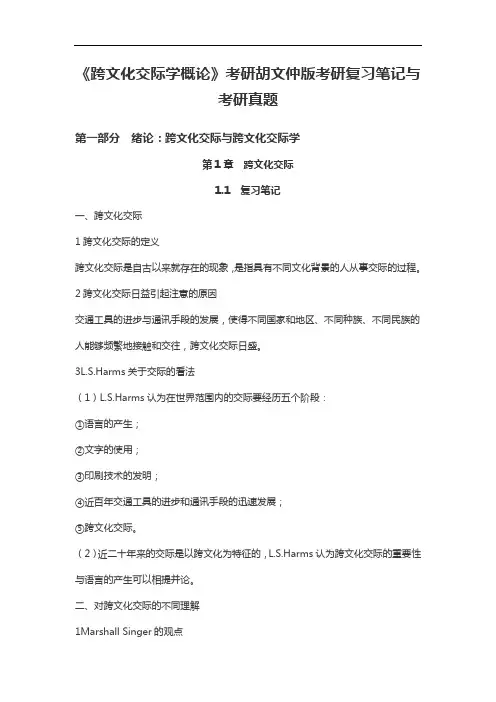
《跨文化交际学概论》考研胡文仲版考研复习笔记与考研真题第一部分绪论:跨文化交际与跨文化交际学第1章跨文化交际1.1 复习笔记一、跨文化交际1跨文化交际的定义跨文化交际是自古以来就存在的现象,是指具有不同文化背景的人从事交际的过程。
2跨文化交际日益引起注意的原因交通工具的进步与通讯手段的发展,使得不同国家和地区、不同种族、不同民族的人能够频繁地接触和交往,跨文化交际日盛。
3L.S.Harms关于交际的看法(1)L.S.Harms认为在世界范围内的交际要经历五个阶段:①语言的产生;②文字的使用;③印刷技术的发明;④近百年交通工具的进步和通讯手段的迅速发展;⑤跨文化交际。
(2)近二十年来的交际是以跨文化为特征的,L.S.Harms认为跨文化交际的重要性与语言的产生可以相提并论。
二、对跨文化交际的不同理解1Marshall Singer的观点(1)每个人都隶属于若干群体,而且,没有两个人隶属的群体是完全相同的。
(2)即使在同一群体中,每个人的态度、价值和信念也不会完全一样。
人们属于不同的群体,在每个群体中的看法又有差异,因此,在文化上每个人都应该是独特的,任何人与人之间的交际都应该被视为跨文化交际。
2Porter和Samovar的观点(1)把各种文化差异放在同一个标尺上,不同国籍与不同职业的人们之间的文化差异并没有什么本质上的区别,只是程度上的差异。
(2)Porter和Samovar的观点在原则上与Singer是一致的,但不像Singer那样过分强调每个人在文化上的独特性。
3Ron和Suzanne Scollon的观点人们属于不同的群体,而不同职业、不同性别、不同年龄的群体都有各自的独特的语篇系统,因此跨文化交际研究应该把重点放在语篇系统方面,研究语篇差异比研究文化差异更有意义。
4对Singer和Scollon观点的评价(1)Singer和Scollon的观点反映了一些学者对于跨文化交际研究中的一些现象的不满。

跨文化交际第四版实用阶梯英语笔记【导言】跨文化交际是当今全球化背景下至关重要的技能之一。
与他人进行跨文化交际,需要我们具备一定的英语能力,同时也需要了解不同的文化习俗和传统。
在这方面,跨文化交际第四版实用阶梯英语笔记给了我们很好的指导和帮助。
本文将深入探讨这一主题,帮助读者更好地理解和应用跨文化交际的相关知识。
【正文】一、跨文化交际的重要性跨文化交际是指不同文化背景下的人们进行交流、合作和互动。
在全球化的今天,跨文化交际变得越来越重要,因为我们经常需要与不同文化背景的人打交道。
而跨文化交际第四版实用阶梯英语笔记对于我们学习和提升跨文化交际能力是非常有益的。
二、跨文化交际第四版实用阶梯英语笔记的特点跨文化交际第四版实用阶梯英语笔记是一部系统介绍英语交际和跨文化沟通的教材。
它通过实用性的案例和知识点,帮助学习者更好地理解和应用英语,同时也关注了不同文化之间的交际技巧和原则。
在笔记中,作者结合了大量的跨文化交际案例和经验,使得学习者能够更加深刻地理解跨文化交际的重要性和技巧。
三、如何有效利用跨文化交际第四版实用阶梯英语笔记在使用跨文化交际第四版实用阶梯英语笔记时,我们可以从以下几个方面进行学习和应用:1. 学习常见的交际技巧和原则:跨文化交际需要我们了解对方文化的基本礼貌和行为规范。
通过学习笔记中的案例和技巧,我们可以更加深入地了解不同文化之间的交际技巧,避免造成不必要的误会和冲突。
2. 加强英语口语和书面表达能力:跨文化交际需要我们具备一定的英语表达能力。
跨文化交际第四版实用阶梯英语笔记通过大量的练习和案例,帮助我们提升英语口语和书面表达能力,使得我们能够更加自如地与他人交流。
3. 建立跨文化交际的意识和能力:跨文化交际不仅仅是语言交流,更重要的是文化之间的理解和尊重。
在使用跨文化交际第四版实用阶梯英语笔记时,我们需要培养跨文化交际的意识和能力,学会在交流中尊重对方的文化差异,避免产生不必要的文化冲突。
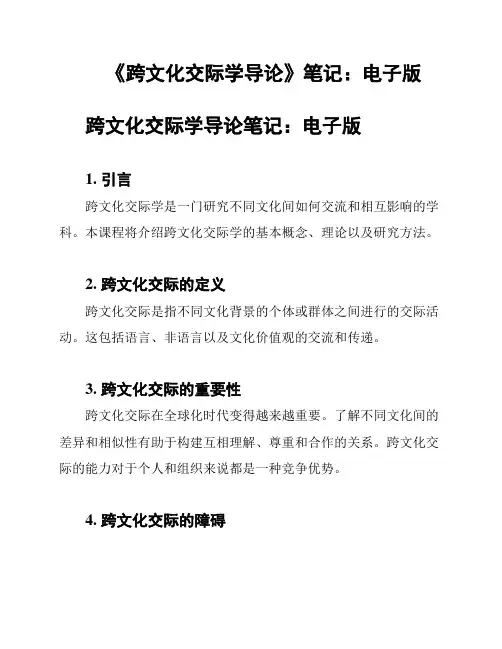
《跨文化交际学导论》笔记:电子版跨文化交际学导论笔记:电子版1. 引言跨文化交际学是一门研究不同文化间如何交流和相互影响的学科。
本课程将介绍跨文化交际学的基本概念、理论以及研究方法。
2. 跨文化交际的定义跨文化交际是指不同文化背景的个体或群体之间进行的交际活动。
这包括语言、非语言以及文化价值观的交流和传递。
3. 跨文化交际的重要性跨文化交际在全球化时代变得越来越重要。
了解不同文化间的差异和相似性有助于构建互相理解、尊重和合作的关系。
跨文化交际的能力对于个人和组织来说都是一种竞争优势。
4. 跨文化交际的障碍在跨文化交际中,存在很多障碍需要克服。
语言障碍、不同的非语言行为、文化偏见和误解都可能导致交际不畅或冲突。
理解这些障碍并学会应对是跨文化交际的关键。
5. 跨文化交际的技巧在跨文化交际中,有一些常用的技巧可以帮助提高交际效果。
包括积极倾听、了解文化差异、避免偏见和刻板印象、以及学会尊重和包容他人的观点。
6. 跨文化交际的研究方法跨文化交际学使用各种研究方法来探索和理解不同文化间的交际现象。
定性研究、定量研究以及实地观察是常见的研究方法。
通过这些方法,我们可以深入了解不同文化间的交际模式和影响因素。
7. 结论跨文化交际学为我们提供了更好地理解不同文化间交际的工具和方法。
通过研究跨文化交际,我们可以更好地适应多元文化环境,促进文化间的理解与合作。
以上是《跨文化交际学导论》的一些笔记。
希望对大家的研究有所帮助。
---。
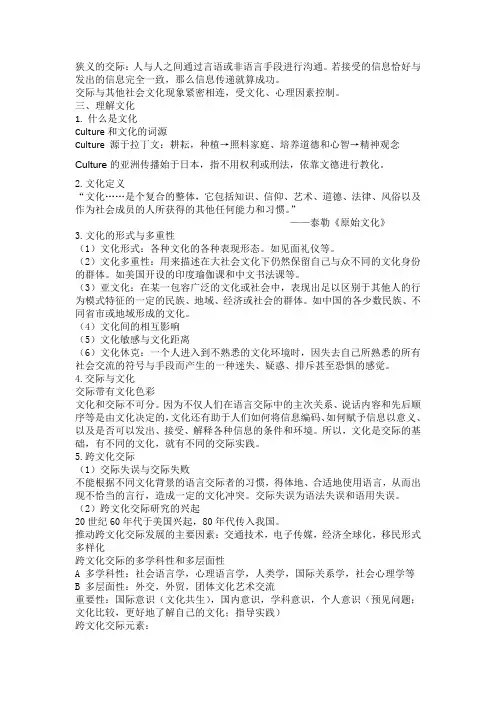
狭义的交际:人与人之间通过言语或非语言手段进行沟通。
若接受的信息恰好与发出的信息完全一致,那么信息传递就算成功。
交际与其他社会文化现象紧密相连,受文化、心理因素控制。
三、理解文化1. 什么是文化Culture和文化的词源Culture 源于拉丁文:耕耘,种植→照料家庭、培养道德和心智→精神观念Culture的亚洲传播始于日本,指不用权利或刑法,依靠文德进行教化。
2.文化定义“文化……是个复合的整体,它包括知识、信仰、艺术、道德、法律、风俗以及作为社会成员的人所获得的其他任何能力和习惯。
”——泰勒《原始文化》3.文化的形式与多重性(1)文化形式:各种文化的各种表现形态。
如见面礼仪等。
(2)文化多重性:用来描述在大社会文化下仍然保留自己与众不同的文化身份的群体。
如美国开设的印度瑜伽课和中文书法课等。
(3)亚文化:在某一包容广泛的文化或社会中,表现出足以区别于其他人的行为模式特征的一定的民族、地域、经济或社会的群体。
如中国的各少数民族、不同省市或地域形成的文化。
(4)文化间的相互影响(5)文化敏感与文化距离(6)文化休克:一个人进入到不熟悉的文化环境时,因失去自己所熟悉的所有社会交流的符号与手段而产生的一种迷失、疑惑、排斥甚至恐惧的感觉。
4.交际与文化交际带有文化色彩文化和交际不可分。
因为不仅人们在语言交际中的主次关系、说话内容和先后顺序等是由文化决定的,文化还有助于人们如何将信息编码、如何赋予信息以意义、以及是否可以发出、接受、解释各种信息的条件和环境。
所以,文化是交际的基础,有不同的文化,就有不同的交际实践。
5.跨文化交际(1)交际失误与交际失败不能根据不同文化背景的语言交际者的习惯,得体地、合适地使用语言,从而出现不恰当的言行,造成一定的文化冲突。
交际失误为语法失误和语用失误。
(2)跨文化交际研究的兴起20世纪60年代于美国兴起,80年代传入我国。
推动跨文化交际发展的主要因素:交通技术,电子传媒,经济全球化,移民形式多样化跨文化交际的多学科性和多层面性A 多学科性:社会语言学,心理语言学,人类学,国际关系学,社会心理学等B 多层面性:外交,外贸,团体文化艺术交流重要性:国际意识(文化共生),国内意识,学科意识,个人意识(预见问题;文化比较,更好地了解自己的文化;指导实践)跨文化交际元素:认知要素:“个体对来自外部世界的刺激进行选择、评估和组织的过程。

《跨文化交际学》阅读笔记一、跨文化交际学的基本概念跨文化交际学是一门研究不同文化背景的人们在交际过程中如何进行交流、沟通以及相互理解的学科。
它涉及到不同文化间的语言、习俗、信仰、价值观等方面的差异,并探究这些差异如何影响人们的交流行为。
在全球化背景下,跨文化交际已成为我们日常生活和工作中不可或缺的一部分,对于增进国际间的合作与交流、促进世界和平与发展具有重要意义。
在跨文化交际学中,有几个核心概念是我们需要掌握的。
首先是“文化”,它是指一个群体或社会共有的语言、艺术、信仰、习俗、传统等行为模式和思想观念的集合。
其次是“交际”,它是指人们通过语言、符号等方式进行信息交流和情感沟通的过程。
而“跨文化交际”则是指来自不同文化背景的人们在交际过程中,通过语言、符号等交流工具,进行信息交换和文化理解的活动。
跨文化交际的核心特点包括多样性和复杂性,由于世界上存在众多不同的文化,每种文化都有其独特的价值体系和行为模式,这使得跨文化交际呈现出多样性。
由于文化差异带来的交流障碍和误解,也给跨文化交际带来了复杂性。
在跨文化交际中,我们需要具备开放的心态和包容的态度,尊重不同文化之间的差异,学会在交流中调整自己的交流策略,以达到更好的交流效果。
为了更好地进行跨文化交际,我们需要了解不同文化间的差异,包括语言、习俗、信仰、价值观等方面的差异。
这些差异可能导致交际中的误解和冲突,因此我们需要通过学习和实践来提升自己的跨文化交际能力,包括语言交际能力、文化适应能力、跨文化意识等方面。
我们才能在全球化的大背景下更好地适应和融入不同的文化环境,促进国际间的交流与合作。
1. 跨文化交际的定义与内涵跨文化交际学是一门研究不同文化背景的人们之间如何进行有效沟通的学科。
在全球化日益发展的今天,跨文化交际的重要性愈发凸显。
在阅读《跨文化交际学》我对其中的定义与内涵有了更深入的了解。
跨文化交际,指的是不同文化背景的人通过语言、符号等交流工具进行信息、情感、观点等的交换过程。
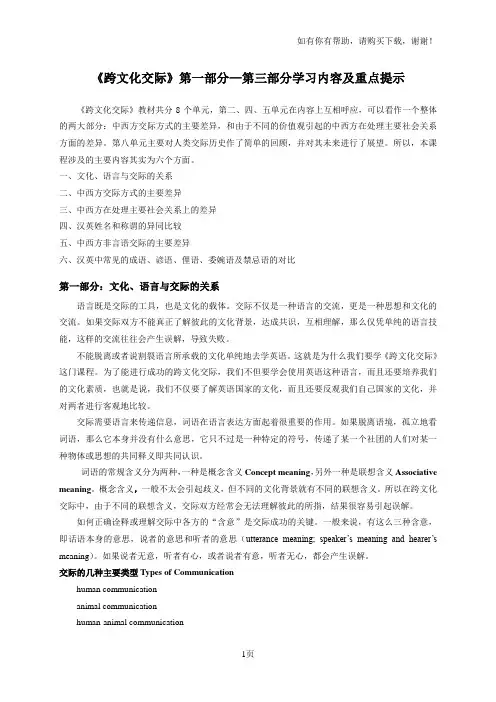
《跨文化交际》第一部分—第三部分学习内容及重点提示《跨文化交际》教材共分8个单元,第二、四、五单元在内容上互相呼应,可以看作一个整体的两大部分:中西方交际方式的主要差异,和由于不同的价值观引起的中西方在处理主要社会关系方面的差异。
第八单元主要对人类交际历史作了简单的回顾,并对其未来进行了展望。
所以,本课程涉及的主要内容其实为六个方面。
一、文化、语言与交际的关系二、中西方交际方式的主要差异三、中西方在处理主要社会关系上的差异四、汉英姓名和称谓的异同比较五、中西方非言语交际的主要差异六、汉英中常见的成语、谚语、俚语、委婉语及禁忌语的对比第一部分:文化、语言与交际的关系语言既是交际的工具,也是文化的载体。
交际不仅是一种语言的交流,更是一种思想和文化的交流。
如果交际双方不能真正了解彼此的文化背景,达成共识,互相理解,那么仅凭单纯的语言技能,这样的交流往往会产生误解,导致失败。
不能脱离或者说割裂语言所承载的文化单纯地去学英语。
这就是为什么我们要学《跨文化交际》这门课程。
为了能进行成功的跨文化交际,我们不但要学会使用英语这种语言,而且还要培养我们的文化素质,也就是说,我们不仅要了解英语国家的文化,而且还要反观我们自己国家的文化,并对两者进行客观地比较。
交际需要语言来传递信息,词语在语言表达方面起着很重要的作用。
如果脱离语境,孤立地看词语,那么它本身并没有什么意思,它只不过是一种特定的符号,传递了某一个社团的人们对某一种物体或思想的共同释义即共同认识。
词语的常规含义分为两种,一种是概念含义Concept meaning,另外一种是联想含义Associative meaning。
概念含义,一般不太会引起歧义,但不同的文化背景就有不同的联想含义。
所以在跨文化交际中,由于不同的联想含义,交际双方经常会无法理解彼此的所指,结果很容易引起误解。
如何正确诠释或理解交际中各方的“含意”是交际成功的关键。
一般来说,有这么三种含意,即话语本身的意思,说者的意思和听者的意思(utterance meaning; speaker’s meaning and hearer’s meaning)。
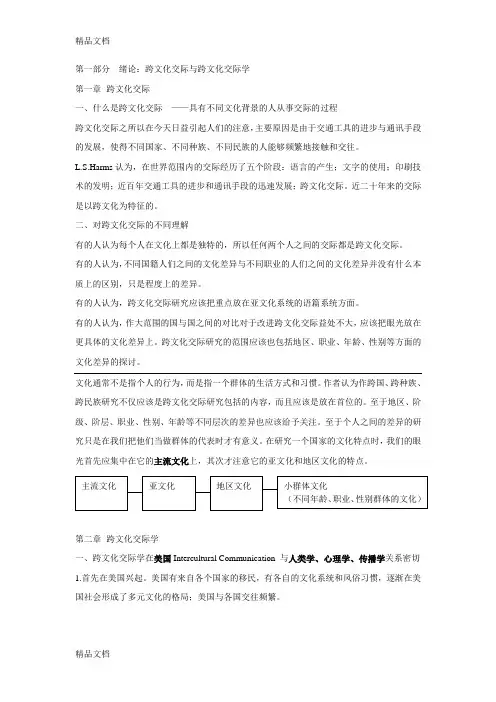
第一部分绪论:跨文化交际与跨文化交际学第一章跨文化交际一、什么是跨文化交际——具有不同文化背景的人从事交际的过程跨文化交际之所以在今天日益引起人们的注意,主要原因是由于交通工具的进步与通讯手段的发展,使得不同国家、不同种族、不同民族的人能够频繁地接触和交往。
L.S.Harms认为,在世界范围内的交际经历了五个阶段:语言的产生;文字的使用;印刷技术的发明;近百年交通工具的进步和通讯手段的迅速发展;跨文化交际。
近二十年来的交际是以跨文化为特征的。
二、对跨文化交际的不同理解有的人认为每个人在文化上都是独特的,所以任何两个人之间的交际都是跨文化交际。
有的人认为,不同国籍人们之间的文化差异与不同职业的人们之间的文化差异并没有什么本质上的区别,只是程度上的差异。
有的人认为,跨文化交际研究应该把重点放在亚文化系统的语篇系统方面。
有的人认为,作大范围的国与国之间的对比对于改进跨文化交际益处不大,应该把眼光放在更具体的文化差异上。
跨文化交际研究的范围应该也包括地区、职业、年龄、性别等方面的文化差异的探讨。
文化通常不是指个人的行为,而是指一个群体的生活方式和习惯。
作者认为作跨国、跨种族、跨民族研究不仅应该是跨文化交际研究包括的内容,而且应该是放在首位的。
至于地区、阶级、阶层、职业、性别、年龄等不同层次的差异也应该给予关注。
至于个人之间的差异的研究只是在我们把他们当做群体的代表时才有意义。
在研究一个国家的文化特点时,我们的眼光首先应集中在它的主流文化上,其次才注意它的亚文化和地区文化的特点。
第二章跨文化交际学一、跨文化交际学在美国Intercultural Communication 与人类学、心理学、传播学关系密切1.首先在美国兴起。
美国有来自各个国家的移民,有各自的文化系统和风俗习惯,逐渐在美国社会形成了多元文化的格局;美国与各国交往频繁。
2.Edwar Hall 《无声的语言》跨文化交际学的奠基之作。
认为不同文化背景的人们在使用时间、空间表达意义方面表现出明显的差异。

跨文化交际P116-117 I or A (inappropriate or appropriate)1.Is it appropriate of Anna to ask Ben this question "Can we talk about us?" A2.Is it appropriate of Anna to ask Ben to tell her what makes him feel loved and close to her? A3.Is it appropriate of Anna to thank Ben for being so supportive tell Ben she fell closer ever than him. A?4.Why did Anna ask Ben "Can we talk about us?”D。
She wanted to thank Ben for being supportive。
5.Why was Ben reluctant to have a talk with his fiance?(声调)B. Ben thought it was pointless to talk about their healthy relationship。
6.Why do women ask their partner ”Can we talk about us” when their relationships are healthy?C. They wanted some attention。
/ D。
It is a sense of insecurity。
7.How did Anna feel when Ben was reluctant to talk to her?B. Her feelings was hurt。
8.Why do some women like to ask their partner "Can we talk about us”? ( 注意与6题区分)——For women,their relationship is a popular topic.9.Is it appropriated for her to ask you to landscape her garden? A10.Is it appropriated for her to ask you how much you want to do the job? I11.Is it appropriated for you to tell her "You don’t have to pay me。
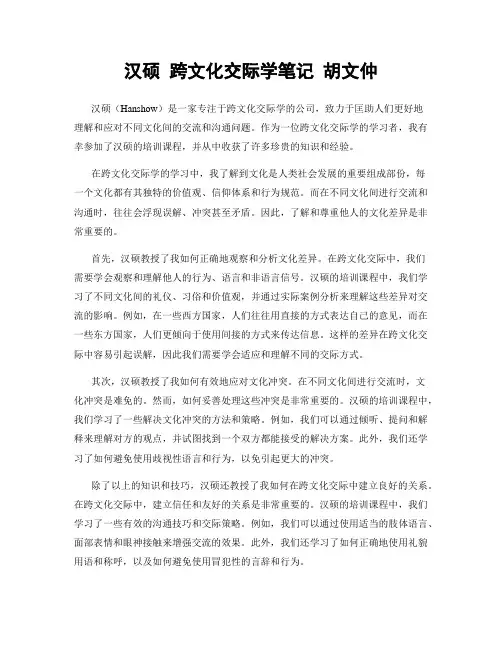
汉硕跨文化交际学笔记胡文仲汉硕(Hanshow)是一家专注于跨文化交际学的公司,致力于匡助人们更好地理解和应对不同文化间的交流和沟通问题。
作为一位跨文化交际学的学习者,我有幸参加了汉硕的培训课程,并从中收获了许多珍贵的知识和经验。
在跨文化交际学的学习中,我了解到文化是人类社会发展的重要组成部份,每一个文化都有其独特的价值观、信仰体系和行为规范。
而在不同文化间进行交流和沟通时,往往会浮现误解、冲突甚至矛盾。
因此,了解和尊重他人的文化差异是非常重要的。
首先,汉硕教授了我如何正确地观察和分析文化差异。
在跨文化交际中,我们需要学会观察和理解他人的行为、语言和非语言信号。
汉硕的培训课程中,我们学习了不同文化间的礼仪、习俗和价值观,并通过实际案例分析来理解这些差异对交流的影响。
例如,在一些西方国家,人们往往用直接的方式表达自己的意见,而在一些东方国家,人们更倾向于使用间接的方式来传达信息。
这样的差异在跨文化交际中容易引起误解,因此我们需要学会适应和理解不同的交际方式。
其次,汉硕教授了我如何有效地应对文化冲突。
在不同文化间进行交流时,文化冲突是难免的。
然而,如何妥善处理这些冲突是非常重要的。
汉硕的培训课程中,我们学习了一些解决文化冲突的方法和策略。
例如,我们可以通过倾听、提问和解释来理解对方的观点,并试图找到一个双方都能接受的解决方案。
此外,我们还学习了如何避免使用歧视性语言和行为,以免引起更大的冲突。
除了以上的知识和技巧,汉硕还教授了我如何在跨文化交际中建立良好的关系。
在跨文化交际中,建立信任和友好的关系是非常重要的。
汉硕的培训课程中,我们学习了一些有效的沟通技巧和交际策略。
例如,我们可以通过使用适当的肢体语言、面部表情和眼神接触来增强交流的效果。
此外,我们还学习了如何正确地使用礼貌用语和称呼,以及如何避免使用冒犯性的言辞和行为。
通过参加汉硕的培训课程,我对跨文化交际学有了更深入的了解,并学到了许多实用的技巧和方法。
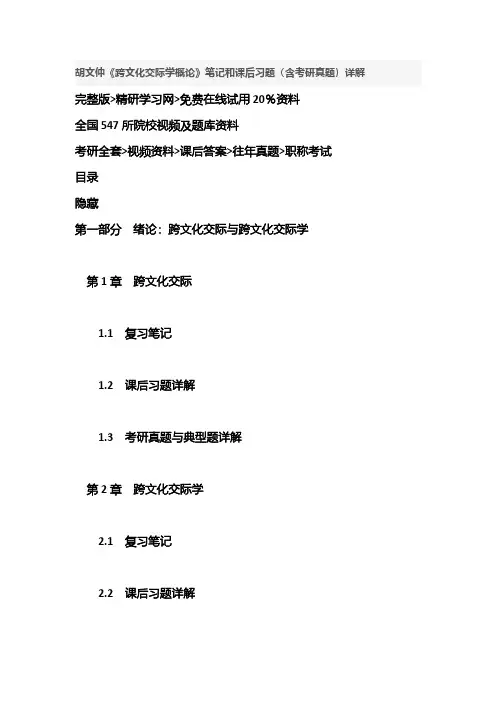
胡文仲《跨文化交际学概论》笔记和课后习题(含考研真题)详解完整版>精研学习网>免费在线试用20%资料全国547所院校视频及题库资料考研全套>视频资料>课后答案>往年真题>职称考试目录隐藏第一部分绪论:跨文化交际与跨文化交际学第1章跨文化交际1.1复习笔记1.2课后习题详解1.3考研真题与典型题详解第2章跨文化交际学2.1复习笔记2.2课后习题详解2.3考研真题与典型题详解第二部分基本概念:文化与交际第3章文化的定义与特性3.1复习笔记3.2课后习题详解3.3考研真题与典型题详解第4章交际4.1复习笔记4.2课后习题详解4.3考研真题与典型题详解第三部分跨文化交际的过程第5章语言交际5.1复习笔记5.2课后习题详解5.3考研真题与典型题详解第6章非语言交际6.1复习笔记6.2课后习题详解6.3考研真题与典型题详解第7章社会交往7.1复习笔记7.2课后习题详解7.3考研真题与典型题详解第8章人际关系8.1复习笔记8.2课后习题详解8.3考研真题与典型题详解第9章经营管理9.1复习笔记9.2课后习题详解9.3考研真题与典型题详解第四部分跨文化交际的核心第10章价值观10.1复习笔记10.2课后习题详解10.3考研真题与典型题详解第五部分提高跨文化意识第11章跨文化交际的障碍11.1复习笔记11.2课后习题详解11.3考研真题与典型题详解第12章文化休克与跨文化训练12.1复习笔记12.2课后习题详解12.3考研真题与典型题详解内容简介隐藏本书是胡文仲《跨文化交际学概论》教材的学习辅导书,主要包括以下内容:1.整理名校笔记,浓缩内容精华。
在参考了国内外名校名师讲授该教材的课堂笔记基础上,复习笔记部分对该章的重难点进行了整理。
因此,本书的内容几乎浓缩了该教材的知识精华。
2.解析课后习题,提供详尽答案。
本书参考了该教材的国内外配套资料和其他教材的相关知识对该教材的课(章)后习题进行了详细的分析和解答,并对相关重要知识点进行了延伸和归纳。

crossculture跨⽂化考试笔记跨⽂化交际学的课堂笔记I. Culture and Intercultural CommunicationCulture:●Culture may be defined as what a society does and thinks. (Sapir, 1921)●Culture refers to the total way of life of particular groups of people. It includes everythingthat a group of people thinks, says, does, and makes. (R. Kohls, 1979)●Culture is a learned set of shared interpretations about beliefs, values, and norms, whichaffect the behavior of a relatively large group of people.⽂化是习得的⼀套关于信仰、价值观、规范的公认的解释,这些信仰、价值观、规范对相当⼤⼈类群体的⾏为产⽣影响。
The Characteristics of Culture:1.Culture is not innate; it is learned;2.Culture is transmissible from person to person, group to group, and generation togeneration;3.Culture is a dynamic system that changes continuously over time;4.Culture is selective; (every culture represents a limited choice of behavior patterns)5.Culture is composed of interrelated facets;6.Culture is ethnocentric (centeredness on one’s own group).The American sociolinguist D. Hymes pointed out that people with communicative competence should know when, where and what to speak to whom and how.Models of communicationTheoretically, the model of communication is always described in the following way:Communication is exchanging information in the form of messages, symbols, thoughts, signs and opinions.The Ingredients of Culture●Language;●Religion;●Values and attitudes;●Education;●Social organization;●Technology and material culture;●Politics;●LawIntercultural Communication (IC)●In its most general sense, IC refers to those occasions when a member of oneculture produces a message for consumption by a member of another culture. (p70, Samovar & Porter)●More precisely, IC refers to communication between people whose cultureperceptions and symbol systems are distinct enough to alter the communication event.(p70, Samovar & Porter)跨⽂化交际:指拥有不同⽂化认知和符号体系的⼈们之间进⾏的交际。
英语跨文化交际手写笔记What is the process of communication —— people with different cultural backgrounds engage in communication. The main reason why cross-cultural communication has increasingly attracted people's attention today is that the progress of transportation means and the development of communication means enable people from different countries, different races and different ethnic groups to frequently contact and communicate with them.L.S.Harms believes that communication worldwide has experienced five stages: the generation of language; the use of words; the invention of printing technology; the progress of transportation and the rapid development of communication; and cross-cultural munication over the last two decades is characterized by cross-cultural aspects. Second, different understandings of cross-cultural communication Some people think that everyone is culturally unique, so the communication between any two people is cross-cultural communication.Some people believe that there is no essential difference between cultural differences between different nationalities and people of different professions, but only differences in degree. Some people believe that cross-cultural communication research should focus on the discourse system of subcultural systems. Some people believe that large-scale nationalcomparisons will have little benefit to improvingcross-cultural communication, and that attention should be focused on more specific cultural differences.The scope of intercultural communication research should also include the discussion of cultural differences in region, occupation, age, gender, etc. Culture usually does not refer to the behavior of an individual, but to the lifestyle and habits of a group.The authors believe that doing transnational, cross-ethnic and cross-ethnic research should not only be the content of intercultural communication research, but also should be put first.As for the differences in region, class, class, occupation, gender, and age, we should also be paid attention to.Studies of differences between individuals only make sense when we treat them as representatives of groups.When studying the cultural characteristics of a country, our vision should first focus on its mainstream culture, and then pay attention to the characteristics of its subculture and regional culture.。
汉硕跨文化交际学笔记胡文仲汉硕跨文化交际学笔记胡文仲一、引言跨文化交际学是研究不同文化之间的交流和相互影响的学科。
在全球化的背景下,跨文化交际能力对于个人和组织的成功至关重要。
本文将从跨文化交际的定义、重要性以及相关理论和实践等方面进行探讨。
二、跨文化交际的定义跨文化交际是指在不同文化背景下,个体或群体之间进行信息交流和相互理解的过程。
这种交流涉及到语言、行为、价值观念、信仰和社会规范等方面的差异。
跨文化交际的目标是促进不同文化之间的和谐与合作。
三、跨文化交际的重要性1. 促进商业合作:随着全球化的加速,企业之间的国际合作变得越来越频繁。
具备跨文化交际能力的人员可以帮助企业更好地理解和适应不同国家和地区的商业环境,提高合作效率和质量。
2. 促进文化交流:跨文化交际有助于不同文化之间的相互了解和尊重。
通过跨文化交际,人们可以更好地理解他人的观点、价值观和行为习惯,促进文化交流和融合。
3. 提高个人竞争力:具备跨文化交际能力的个人在求职和职业发展方面具有明显的竞争优势。
跨文化交际能力被越来越多的企业和组织视为重要的招聘和晋升标准。
四、跨文化交际的理论和实践1. 文化维度理论:霍夫斯泰德提出的文化维度理论认为,不同文化之间存在着六个维度的差异,包括权力距离、个人主义与集体主义、男性气质与女性气质、不确定性规避、长期导向和短期导向。
了解和应用这些维度可以帮助人们更好地理解和适应不同文化的交际方式。
2. 跨文化沟通技巧:跨文化交际需要掌握一定的沟通技巧。
例如,要尊重对方的文化差异,避免使用具有歧视性的语言;要注意非语言沟通的重要性,如姿势、表情和眼神等;要善于倾听和提问,以促进双方的理解和沟通。
3. 跨文化冲突管理:跨文化交际中常常会出现冲突和误解。
管理跨文化冲突需要灵活应对,尊重对方的观点,善于解释和沟通,寻找共同的利益和解决方案。
五、结论跨文化交际学是一个复杂而重要的学科,对于个人和组织的成功具有重要意义。
Culture: Culture is the total accumulation of beliefs, customs, values, behaviors, institutions and communication patterns that are shared, learned and passed down through the generations in an identifiable group of people.Objective Culture: history, religion, literature, language, food, etiquette, law, and customs.Subjective Culture: feelings and attitudes about how things are and how they should be –the concept of time, spaces, friendship, love, family, communication pattern, etc.Characteristics:Learned, transmitted from generation to generation, based on symbols, dynamic, ethnocentric.Doing Culture: It is meant to be a contrast to learning “about” culture underscores the idea that communicating across cultures is a process of making meaning, of people understanding one another so they can get to know one another, build relationships, and solve problems together. It should not be words on paper, but ideas in practice.Communication: Human communication is the process through which individuals –in relationships, groups, organizations and societies –respond to and create messages to adapt to the environment and one another.Characteristics: Dynamic and interactiveIntercultural Communication: Generally speaking, it refers to interaction between people from different cultural backgrounds, such as interactions between people from America and China, between whites and African Americans, between Hispanic and Japanese AmericansThe form of Intercultural Communicationa. Interracial communication –people from different racesb. Interethnic communications –the parties are of the same race but of different ethnic origins.c. Intercultural communication –communication between members of the sameculture, in which one or both of the participants hold dual or multiple memberships.(gay, disabled, Mexican American, African American, or female)Communication Competence (ICC competence)The cognitive component –how much one know about communication.The affective component –one’s motivation to approach or avoid communication The behavior component –the skills one has to interact competently. Perception: Perception is a cognitive process in which we attach meaning to objects, symbols, people and behavior in order to make sense of them.Pattern of Thought: The way people in a culture think influences the way they interpret strangers’ messages.World views: The grid (decentralized. This pattern does not have a fixed center) The radiating star (highly centralized. In this pattern important things are at the center and everything else radiates out from the center)The inside/ outside pattern (圈子)female maleprivate publichome market, mosque, coffee housethe outside is plain, not welcoming, even forbidding. The walls are thick to protect what is inside.highly centralized pattern: important people sit in the front middle;decentralized pattern: people sit equally.Stereotyping: People generalize to make sense of his experience. The result of the process of over generalizing based on limited or inaccurate information.The classification of stereotypes1. Negative stereotype of other cultures: Prejudice (severe prejudice)2. Positive stereotype of one’s own culture: Cultural superiority Characteristics: universal, unavoidable, stable, variable, ethnocentrismHigh context communication & Low context communicationHC culture (察言观色): Relies mainly on the physical context or the relationship for information, with little explicitly encoded.LC culture: provide most of the information in the explicit code itself.Perception: Perception is a cognitive process in which we attach meaning to objects, symbols, people and behavior in order to make sense of them.High contact and low contact culture:In high contact cultures people want to get close enough to one another and to objects to sense them in these ways.People in these countries stand closer, touch more, engage in more eye contact and speak more loudly than people do in lower-contact cultures.In a low contact cultures, people rely more on sight, and especially sight at a far distance. People are most likely to stand a certain distance away to get the whole picture, without actually feeling or sensing the other person’s body heat or subtle smell.So in low contact culture as America, one is taught not to breathe on people.However, this visual space seems unfriendly and indifferent to those from high contact cultures, which favor tactile space.When a person from a high contact culture goes to a low contact culture, he or she is likely to feel that people are cold, lack human warmth, and are indifferent and pay no attention to them.low-contact: Asia ; moderate-contact: Australia, Northern Europe, United States high-contact: South America, Mediterranean, the Arab worldLarge and smell Power Distancespower distance is an attempt to measure cultural attitudes about inequality insocial relationships.In high power distance cultures, position in a hierarchy is considered to benatural and important. People are expected to show only positive emotions toothers with high status and to display negative emotions to those with low status;tend to decrease gaze in the presence of powerful people.Low Power Distance Culture: Minimize and eliminate the differences in power and status; more emotional display, increase the amount of gaze. People believe that the differences in power between boss and workers should be reduced and not mphasized.Individualism VS CollectivismThe individualism index measures the extent to which the interests of the individual are considered to be more important than the interests of the group. People from individualist cultures are more likely to act on principles that apply to everyone, principles that are universal and apply to associates and strangers alike. Collectivists are not unprincipled, but when making decisions they tend to give a higher priority to relationships than individualists do. They expect people who are involved in a group relationship to have duties and obligations to one another. Masculinity (Toughness) VS Femininity (Tenderness)Masculinity means everyone in society embraces values that have traditionally been associated with men, that is assertiveness, competitiveness and toughness. On the feminine side of the scale we find societies in which people generally embrace values that have traditionally been labeled as feminine, that is modesty, cooperation and tenderness.Strong and weak Uncertainty AvoidanceThe Uncertainty Avoidance Index seeks to measure the extent to which people in a particular society are able to tolerate the unknowns of life. In high uncertainty avoidance countries people experience more stress and a sense of urgency as they go through their daily routines. Relationships are guided by strict rules. People from low uncertainly avoidance countries do not have a strong need to control things, people, and events by clearly defining and categorizing them. Relationships are guided by strict rules.Intercultural CommunicationIntercultural CommunicationGenerally speaking, it refers to interaction between people from different cultural backgrounds, such as interactions between people from America and China, between whites and African Americans, between Hispanic and Japanese Americans The form of Intercultural Communicationa. Interracial communication –people from different racesb. Interethnic communications –the parties are of the same race but of different ethnic origins.c. Intracultural communication –communication between members of the sameculture, in which one or both of the participants hold dual or multiple memberships.(gay, disabled, Mexican American, African American, or female)Language&CulturePeople pay attention to basic language in cross-culture communication because of the essential role these codes play in communication and they are part of object culture. The same word may stir up different associations in people under different cultural background, e.g. the word “dog”. In eastern culture, dogs are dirty, brutal and stupid. But in western culture, dogs are lovely, loyal and obedient. They are faithful friends and compassionate animals.Language reflects culture. Language expresses cultural reality, reflects the people’s attitudes, beliefs, world outlooks, etc. For example, American businessmen often encode their meanings in metaphors and images from these sports.Chinese traditional sport culture emphasizes the harmony between human beings and oneness between man and nature. It is morality, benevolence, entertainment and longevity. But western sports culture is competition and sportsmanship.Culture shock: Troublesome feelings such as depression, loneliness, confusion, inadequacy, hostility, frustration, and tension, caused by the loss of familiar cues from the home culture.U-Curuemodel:Excitement→Confusion→Frustration→Effectiveness→Appreciation。
第一章跨文化交际一、什么是跨文化交际——具有不同文化背景的人从事交际的过程跨文化交际之所以在今天日益引起人们的注意,主要原因是由于交通工具的进步与通讯手段的发展,使得不同国家、不同种族、不同民族的人能够频繁地接触和交往。
L.S.Harms认为,在世界范围内的交际经历了五个阶段:语言的产生;文字的使用;印刷技术的发明;近百年交通工具的进步和通讯手段的迅速发展;跨文化交际。
近二十年来的交际是以跨文化为特征的。
二、对跨文化交际的不同理解有的人认为每个人在文化上都是独特的,所以任何两个人之间的交际都是跨文化交际。
有的人认为,不同国籍人们之间的文化差异与不同职业的人们之间的文化差异并没有什么本质上的区别,只是程度上的差异。
有的人认为,跨文化交际研究应该把重点放在亚文化系统的语篇系统方面。
有的人认为,作大范围的国与国之间的对比对于改进跨文化交际益处不大,应该把眼光放在更具体的文化差异上。
跨文化交际研究的范围应该也包括地区、职业、年龄、性别等方面的文化差异的探讨。
文化通常不是指个人的行为,而是指一个群体的生活方式和习惯。
作者认为作跨国、跨种族、跨民族研究不仅应该是跨文化交际研究包括的内容,而且应该是放在首位的。
至于地区、阶级、阶层、职业、性别、年龄等不同层次的差异也应该给予关注。
至于个人之间的差异的研究只是在我们把他们当做群体的代表时才有意义。
在研究一个国家的文化特点时,我们的眼光首先应集中在它的主流文化上,其次才注意它的亚文化和地区文化的特点。
主流文化亚文化地区文化小群体文化(不同年龄、职业、性别群体的文化)第二章跨文化交际学一、跨文化交际学在美国Intercultural Communication 与人类学、心理学、传播学关系密切1.首先在美国兴起。
美国有来自各个国家的移民,有各自的文化系统和风俗习惯,逐渐在美国社会形成了多元文化的格局;美国与各国交往频繁。
2.Edwar Hall 《无声的语言》跨文化交际学的奠基之作。
跨文化交际学概论笔记一、引言跨文化交际学是研究不同文化背景下人们之间的交际行为和相互理解的学科。
它关注的是不同文化之间的差异和相似之处,以及如何在跨文化环境中进行有效的交流和互动。
本文将介绍跨文化交际学的定义、重要性以及相关的理论框架。
二、跨文化交际学的定义跨文化交际学是一门综合性学科,它研究的是在不同文化背景下人们之间的交际行为和相互理解。
跨文化交际学旨在帮助人们更好地理解和应对不同文化之间的差异,促进跨文化交流和互动的顺利进行。
三、跨文化交际学的重要性1. 促进文化交流和理解:跨文化交际学可以帮助人们更好地理解和尊重不同文化的差异,从而促进跨文化交流和理解。
2. 提高跨文化沟通的效果:通过学习跨文化交际学,人们可以了解不同文化之间的交际规则和习惯,从而提高跨文化沟通的效果。
3. 增进国际合作和发展:跨文化交际学对于促进国际合作和发展具有重要意义,可以帮助不同国家和地区之间建立良好的合作关系。
四、跨文化交际学的理论框架1. 文化维度理论:文化维度理论是跨文化交际学中的重要理论框架之一,它通过对不同文化之间的差异进行分类和比较,帮助人们更好地理解不同文化的特点和习惯。
2. 社会认知理论:社会认知理论研究人们在跨文化交际过程中的认知和理解方式,包括对他人行为的解释和理解。
3. 语言和交际行为理论:语言和交际行为理论研究语言在跨文化交际中的作用和影响,包括语言的表达方式、语言的符号和意义等。
五、跨文化交际的挑战和应对策略1. 语言障碍:不同文化之间的语言差异可能导致交流的困难,应加强语言学习和提高语言能力。
2. 文化差异:不同文化之间的差异可能导致误解和冲突,应加强对不同文化的了解和尊重。
3. 价值观差异:不同文化之间的价值观差异可能导致观念冲突,应尊重对方的价值观,并寻求共同点。
六、结论跨文化交际学的研究对于促进不同文化之间的交流和理解具有重要意义。
通过学习跨文化交际学,人们可以更好地应对跨文化环境中的挑战,促进国际合作和发展。
跨文化交际P116-117 I or A (inappropriate or appropriate)1.Is it appropriate of Anna to ask Ben this question "Can we talk about us?" A2.Is it appropriate of Anna to ask Ben to tell her what makes him feel loved and close to her? A3.Is it appropriate of Anna to thank Ben for being so supportive tell Ben she fell closer ever than him. A?4.Why did Anna ask Ben "Can we talk about us?"D. She wanted to thank Ben for being supportive.5.Why was Ben reluctant to have a talk with his fiance?(声调)B. Ben thought it was pointless to talk about their healthy relationship.6.Why do women ask their partner "Can we talk about us" when their relationshipsare healthy?C. They wanted some attention./D. It is a sense of insecurity.7.How did Anna feel when Ben was reluctant to talk to her?B. Her feelings was hurt.8.Why do some women like to ask their partner "Can we talk about us"? ( 注意与6题区分)——For women, their relationship is a popular topic.9.Is it appropriated for her to ask you to landscape her garden? A10.Is it appropriated for her to ask you how much you want to do the job? I11.Is it appropriated for you to tell her "You don't have to pay me."? A12.Is it appropriated for her to pay you more than you ask for? In China, A13.Why did you agree to help her landscape her garden?D. You are being helpful.14.Why did she asked you to landscape her garden?D.She thought that it would be good to have a new garden.15.Why did she insist that you make sure "there is 200 dollars in the envelope"?B.To make sure you get what you ask for.16.What would you have done if you were the lady who asked a friend to landscapeher garden? ——I would have paid more money.(与最后一题相关)17.Why did you say "you don't have to pay me."?B.You wanted to return her a favor for helping you.18.You think that it is strange for an American because he takes cold bath and drinks boiled water. I19.If you are a man in the English speaking countries,and a lady comes into the room,you must rise to your feet. A20.If you have a question to ask your foreign teacher of English ,you may say goodbyeto him and leave immediately after you have got the answer and show your grattitude. A21.When you are eating with an English friend, you wish him,"Good appetite!" I22.Jack, a foreign student in China, called at your house and asked if you mindedhim smoking. If you hate the smell of tobacco, you may say,"Would you mind I said no?" A23.If a native speaker of English says to you,"That's a very nice coat you're wearing",you can answer it by saying,"Do you really like it?" I24.In New York Chen Ming called a taxi and said to the driver,"Would mind taking me to the airport?" I25.If you are a male and introduced to an English speaking lady,you don't take the initiative in shaking hands unless she holds out her hands first. A (与office礼节相反)26.When you break a plate in one of your friends' house,you say,"I'm awfully sorry, but I seem to have broken a plate." A27.In England you should remember that drugs may not be available without a doctor's prescription. A28.Many English houses are known only by a name. If you have difficulty in finding such a house, you may try asking the local shopkeepers. A29.Mrs. Godwin was about the same age as Li Ming's grandmother, so intimately you called her "Grandma." I30.When you give your hostress the flowers you have brought her, you should remove the wrapping paper first. In the West, I31.On his way to the school cinema, Li Hong saw Professor Janes walking to the cinema,too. Li said,"You're going to see the film,aren't you?" I32.You don't need to tip the girl who shows you to your seat in a cinema or a theatre in the UK. A33.On a cold winter day Wang Ming meet Professor Briner on his way to the library.Wang said to him,"It's rather cold,you'd better wear more clothes." I34.Betty is a foreign student in China. She met Feng Mei and said to her,"I was told that you the 200-meter race in the all-city track meet this morinig". Feng replied, "Just lucky". I35.When you want to compliment(赞美) your young English friends' new coat, you can say, "I like your new coat." A36.If you study as a graduate student in the U.S.A, you would always try to avoid telephoning your American classmates at sometimes later than 11p.m. Unless there is an emergency. A37.Wang Lin called at one of his foreign friends' house. He was really impressed by the beautiful curtains(窗帘) made by his friend's wife. He said to her,"Well.I didn't expect you could make such pretty curtains." I38.If you want borrow a typewriter(打印机) from your English friend, you say," Is there my chance of borrowing your typewriter?" A39.Mrs. Brown, in her late forties, came to the lecture,wearing a new dress. One of her students said to her, "You look nice and younger wearing this dress." I 40.It is appropriate for you to pick up food with your chopsticks for your foreign guest during dinner. A41.When you are feeling under the weather(=sick) and want to go see doctor, it is good to make an appointment before you go. A42.If you want to go see one of your American or English friends, you can do it after lunch. A43.If you are a college student and meet during the break in an academic conference an American Professor who is a friend of your supervisor's, you can go and havea talk with him as long as the break permit. A44.If when you study at a college in an English-speaking country you feel ill and therefore cannot attend lesson, you'd better go and see the doctor and ask him to write you a certificate for sick leave. A45.Dr. Smith, over 60, invited Li Bing to his birthday party. Li Bing brought hima Chinese god of longevity as a present. I(其它AB卷见网工笔记本)友情提示:本资料代表个人观点,如有帮助请下载,谢谢您的浏览!。
Teaching Plan
I. Teaching Plan:
----1 unit/week, 16 units for 16 weeks
----30% assignments ets+70% final exam
II. Contents
1.Chapter One Culture
2.Chapter Two Cultural Dynamics
3.Chapter Three Communication
4.Chapter IV Intercultural Communication
5.Chapter Five Cultural Values
6.Chapter Six Culture’s Influence on Perception
7.Chapter Seven Intercultural Communication Barriers
8. Chapter Eight Verbal Intercultural Communication (I)
9. Chapter Nine Verbal Intercultural Communication (II)
10. Chapter Ten Nonverbal Communication
11. Chapter XI Global Social Customs and Business Etiquette
12. Chapter Twelve Effective Intercultural
Communication Competence
Chapter One Culture
Questions for discussion:
1.What’s culture?(examples and definitions)
some cultures.
3.What’s the uses of learning a particular culture?/What does
culture can help/ Is it necessary to learn culture?
( Your culture and other’s culture)
4.Whom do you learn a culture from?
5.Definition of culture
6.Characteristics of culture
7.Cultural Identity: definition and examples and formation and
characteristics.
Enculturation,acculturation,separation,segregation, integration,assimilation, marginalization ,and culture shock cultural conflict host culture
To identify the definitions of
enculturation,ɪn kʌlt∫ə`reɪ∫ən n. 对某种文化的适应
acculturation, ə kʌlt∫ə՝rei∫ən n. 文化传入, 文化适应separation,
segregation, segri՝gei∫ən n. 种族隔离
integration,inti՝grei∫ən n. 综合
assimilation, ə sɪmɪ`leɪ∫ən ]n. 同化, 同化作用, 消化marginalization边缘化
and culture shock 文化冲击
cultural conflict 文化冲突
host culture主文化(要学习的别人的问话)
中国作为东道主文化(host culture),对于国外汉学家从事对自己文化研究的努力,一般都表现出友善和欢迎的态度。
Predictors
Unit 5 Values
Definitions:
Low context culture and high context culture
Low context and High context communication
High-context culture rely on implicit nonverbal actions & environmental setting to convey meanings,unlike low-context cultures,which rely heavily on explicit verbal communication.
Low-context cultures concentrate on every detail of a decision,whereas high-context cultures build relationships & trust.
Low-context cultures encourage open disagreement,whereas high-context cultures avoid conformation & debate.
Low-context cultures view negotiations impersonally as a series of problems to be overcome. High-context cultures emphasize harmony & agreement to be worked out.
Low-context cultures tend to value written agreements & interpret laws
strictly,whereas high-context cultures view adherence to laws as being more
flexible.。